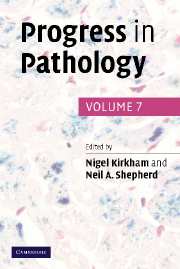Book contents
- Frontmatter
- Contents
- List of Contributors
- Preface
- 1 The microbiological investigation of sudden unexpected death in infancy
- 2 An overview of childhood lymphomas
- 3 Assessment of the brain in the hospital consented autopsy
- 4 The value of immunohistochemistry as a diagnostic aid in gynaecological pathology
- 5 The role of the pathologist in the diagnosis of cardiomyopathy: a personal view
- 6 Metastatic adenocarcinoma of unknown origin
- 7 Immune responses to tumours: current concepts and applications
- 8 Post-mortem imaging – an update
- 9 Understanding the Human Tissue Act 2004
- 10 The Multidisciplinary Team (MDT) meeting and the role of pathology
- 11 Drug induced liver injury
- Index
- References
8 - Post-mortem imaging – an update
Published online by Cambridge University Press: 06 January 2010
- Frontmatter
- Contents
- List of Contributors
- Preface
- 1 The microbiological investigation of sudden unexpected death in infancy
- 2 An overview of childhood lymphomas
- 3 Assessment of the brain in the hospital consented autopsy
- 4 The value of immunohistochemistry as a diagnostic aid in gynaecological pathology
- 5 The role of the pathologist in the diagnosis of cardiomyopathy: a personal view
- 6 Metastatic adenocarcinoma of unknown origin
- 7 Immune responses to tumours: current concepts and applications
- 8 Post-mortem imaging – an update
- 9 Understanding the Human Tissue Act 2004
- 10 The Multidisciplinary Team (MDT) meeting and the role of pathology
- 11 Drug induced liver injury
- Index
- References
Summary
INTRODUCTION
There have been huge advances in clinical imaging over the last 10 years that have resulted in an improvement in the visualisation of both morphological and functional pathology.
Imaging techniques have been used to identify bone injury ever since Roentgen produced the first radiograph in 1895. Most of us are familiar with the ongoing utility of X-rays in both paediatric and adult pathology, particularly in a medico-legal context. Skeletal surveys are used to identify fractures in cases of suspected child abuse and to demonstrate bone trauma associated with bullets and other missiles.
In the second half of the 20th Century, more sophisticated imaging techniques were introduced. Computed Axial Tomography (CAT) scans (now Computed Tomography (CT) scans) were introduced in the early 1970s, followed by magnetic resonance imaging (MRI), nuclear medicine and positron emission tomography (PET). Each modality is used in different ways in clinical medicine, maximising their respective strengths and cost-effectiveness.
Autopsy rates, already in decline in England and Wales and elsewhere since the 1950s, further plummeted in the wake of the Alder Hey and Bristol tissue and organ ‘scandals’ of the late 1990s [1]–[3].
There has been an increased interest in the application of clinical imaging techniques to post-mortem diagnoses, either as an adjunct to, or as a replacement of the autopsy [4], [5].
Some of this research has been prompted by certain religious communities, whose attitudes to autopsy have previously been explored in detail [6], [7].
- Type
- Chapter
- Information
- Progress in Pathology , pp. 199 - 220Publisher: Cambridge University PressPrint publication year: 2007

